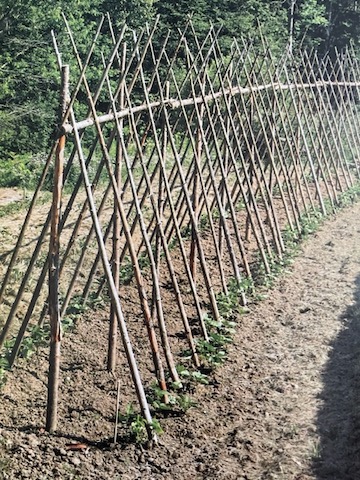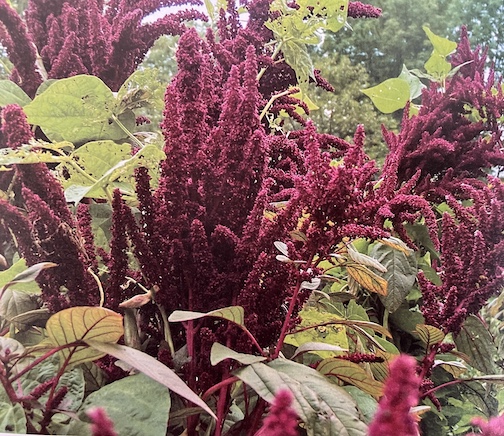By Will Bonsall
Photos courtesy of Yaicha Cowell
A major reason for preferring pole beans over bush types is to save space. By exploiting your garden’s third dimension, you can harvest much more food from a smaller footprint. Of course, all good things come with a price and in this case it is the extra labor. The effort to collect trellis material like poles is considerable even if, like me, you have many acres of fir or other thinnings, and you use the poles year after year. Of course there’s also the time spent erecting and dismantling the structure, assuming that’s how you support them (there are other ways). I use two styles of pole trellis, which I’ll describe briefly.
Now all of my cultivated area is laid out in permanent beds (not raised), 40 feet long and 4 ½ feet wide with paths measuring 1 ½ feet. For trellis style number one, I make a single furrow down the center of the bed, which of course would be very space-wasting, but I also plant a companion crop down either side (broccoli is a favorite). This allows the bean vines to get more sunlight and they yield accordingly. To set the poles in that center row I use a steel bar to make a deep narrow hole, stick in the bean pole (with a tapered point for greater depth) and stomp in the soil around it. By this method each pole is self-supporting. I set the poles 24 inches apart and sow four to six beans per pole. I usually like to run some slender poles horizontally tied near the top of each vertical pole about 6 feet above the ground. This strengthens the whole array and also allows the beans to run laterally from pole to pole. It’s helpful to have another person holding up the opposite end while I’m tying so the lateral poles remain horizontal and stiff. I always save my skinniest poles with the least amount of taper for those laterals.

Incidentally, every few years the bottom ends of the uprights become punky and weak, so I bust those off, re-pointing if necessary, and the poles become a foot or so shorter. Eventually they become too short for bean poles, after which they serve as tomato stakes or support for pea fence. Some folks, lacking abundant forest thinnings, simply erect a top and bottom rail with twine stretched up and down. Despite the extra effort I greatly prefer the poles for greater wind protection.
The second pole configuration goes like this: I set heavy 8-foot-tall poles in the center row, placed 8-10 feet apart. Between them I lash horizontal poles about 6 feet high, creating a “ridgepole.” Then I make a double row of poles, one on either side and about 2 feet from the bed’s center. These are not quite vertical but lean against the ridgepole to which they are lashed as opposing pairs. The butts of these are simply set in the shallow furrows, as they are fastened at the top and in no danger of falling over. I do however lash them firmly at the top as the vine-laden poles may tend to slide lengthwise in a heavy wind. With a foot or two of pole extending up beyond the ridgepole, the appearance is sort of like a linear teepee.
As far as bean yield goes, the second style is much better (after all, there are two rows), though it leaves no room for a companion crop, as with style number one. Well, actually there is room if you do it right. I sometimes plant a very early-in/early-out crop in the center row (between the upright posts), something like spinach, radishes, lettuce or scallions. Earliness is critical, as the crop must be well-advanced before the rampant bean vines can shade them. Of course, a little bit of shade can help keep those early crops from bolting too soon, but timing is important. I aim to sow the companion crop by early May, which means I must have the posts and top-rails in place then (even though the beans themselves won’t be planted for several weeks yet) lest I trample those crops while planting the beans in June. Even when I’m not on my game enough to do all that in time, the beans still give a bodacious yield.
Let me stop right here and emphasize that I only use this trellis system for green (or string) pole beans, not dry pole beans, for which I have a much easier method — wait for it. But first let me point out that the only pole green bean variety worth growing is Jimenez (I know some folks consider other varieties quite acceptable, but then some folks think Elvis is still alive). It is the most heavy-setting, long-yielding, quality-holding variety I’ve ever seen. It is usable even when the pods are somewhat overgrown and other varieties have gone tough and tasteless. Even after that it makes a superb shell bean and an excellent dry bean resembling a fat pinto. But you go ahead and grow whatever kind you want, it makes no difference to me, just don’t say I didn’t warn you.
Up to now we’ve only talked about green or string beans, but what about dry beans? Many folks feel they haven’t enough room for dry beans. Maybe that’s because they haven’t noticed the price of dry beans in shops, or perhaps they think they need equipment, when all it takes is a flail, or even a heavy stick, and a burlap feed bag to thresh them. As with green beans, pole dry beans yield much more than bush types per square foot. Pole dry beans don’t lend themselves to mechanized harvesting, which is why most store-bought dry beans are bush varieties. If you’re going to hand-pick the pods anyway, why not get a lot more of them?
For me the main difference between green and dry pole beans is that I don’t bother to erect a trellis for the dry beans. Rather I interplant them with sunflowers or grain amaranth (a tallish variety like Opopeo), in effect growing the poles as well as the bean crop, except the sunflowers and amaranth are also valuable food crops, so it’s a win-win. Granted, the pole beans don’t yield quite as well among those tall supporting crops, as the shade has a small adverse effect. How much? I find that pole beans on amaranth yield about 75% as much as those on naked poles, but the great value of the amaranth grain (which seems unaffected by the bean vines) easily compensates for the reduced bean yield.

Here’s an important detail about this combination: sunflowers and amaranth are much more cold-hardy than the beans and so can be planted a few weeks earlier. In fact, they must be started earlier to get a head start on the beans, or else the beans will be ready to climb before these crops have enough height to support them. I start both amaranth and sunflowers in cell-trays (in early May), since direct seeding results in some loss to birds and the tiny amaranth seedlings are indistinguishable from their close relative, red-root pigweed, so how to weed them? I set the amaranth seedlings 2 feet apart in rows 3 feet apart, and the sunflowers are seeded three per cell then transplanted to hills 3 feet asunder, in rows 3 feet apart. By the way, an added benefit of this combination is that the bean vines bind the sunflowers together, reducing lodging when the stalks get heavier.
You may wonder why I don’t plant all pole beans that way, rather than using pole trellises for the fresh green types. Green beans need to be picked frequently throughout the season and the sunflower or amaranth combo can be too dense and tangled to access as the season progresses, whereas the dry beans can be harvested at about the same time as the support crop, when both have matured and dried back, so that thrashing around in there will do little damage.
In addition to producing a greater yield, some folks feel that pole beans are fuller flavored than bush types. I’m partly in that camp, although there’s so much variation between varieties of either type that I’m not certain of that. Pole beans are less impacted by fall frosts, not because they’re any more frost-resistant but rather being high above the ground protects the upper part of the plant, while only the lower leaves may be injured. I’ve also noticed that pole beans exhibit more extreme variation in seed size and color. I suspect that may be because so many pole varieties are old heirlooms that may have been selected for aesthetic qualities over commercial traits.
About the author: Will Bonsall lives in Industry, Maine, where he directs Scatterseed Project, a seed-saving enterprise. He is the author of “Will Bonsall’s Essential Guide to Radical Self-Reliant Gardening” (Chelsea Green, 2015). And indeed, he is also a distant cousin of another exemplary Maine horticulturist: Tom Vigue. You can contact Will at [email protected].
Thanks for reading! Become a member today to support the creation of these resources and receive our quarterly newspaper The Maine Organic Farmer & Gardener for more content like this.
